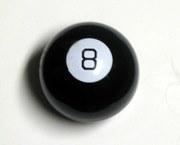Magic 8 Ball: Difference between revisions
Hairy Dude (talk | contribs) m →Origin: don't use ampersand in prose |
Corrected the stupid Berean Hunter's redaction |
||
| Line 13: | Line 13: | ||
==Origin== |
==Origin== |
||
While Magic 8-Ball did not exist in its current form until 1950, the functional component was invented by Albert C. Carter, who was inspired by a "spirit writing" device used by his mother, Mary, a Cincinnati [[clairvoyant]]. When store owner Max Levinson was approached by Carter about stocking the device, he called in his brother-in-law Abe Bookman, a graduate of [[University of Cincinnati College of Applied Science|Ohio Mechanics Institute]]. In 1944, Carter filed patent for his device, assigning it to Bookman, Levinson, and another partner in what came to be Alabe Crafts, Inc. ('''Al'''bert and '''Abe''') in 1946. Under the Alabe name, they marketed and sold the device as The ''Syco-Seer''. Carter, who, according to Bookman, was an alcoholic, died sometime before the patent was granted in 1948. Bookman soon made improvements to the Syco-Seer and in 1948, it was encased in an iridescent [[crystal ball]]. Though unsuccessful, the revamped product caught the attention of Chicago's [[Brunswick Corporation|Brunswick Billiards]]. In 1950 they commissioned Alabe Crafts to make a version in the form of a traditional black and white [[billiard ball|8-ball]].<ref>Walsh, Tim. (2004). ''The Playmakers: Amazing Origins of Timeless Toys'', pp. 94-5. Keys Publishing, Sarasota. ISBN 0-9646973-4-3.</ref> |
While Magic 8-Ball did not exist in its current form until 1950, the functional component was invented by Albert C. Carter, who was inspired by a "spirit writing" device used by his mother, Mary, a Cincinnati [[clairvoyant]]. When store owner Max Levinson was approached by Carter about stocking the device, he called in his brother-in-law Abe Bookman, a graduate of [[University of Cincinnati College of Applied Science|Ohio Mechanics Institute]]. In 1944, Carter filed patent for his device, assigning it to Bookman, Levinson, and another partner in what came to be Alabe Crafts, Inc. ('''Al'''bert and '''Abe''') in 1946. Under the Alabe name, they marketed and sold the device as The ''Syco-Seer''. Carter, who, according to Bookman, was an alcoholic, died sometime before the patent was granted in 1948. Bookman soon made improvements to the Syco-Seer and in 1948, it was encased in an iridescent [[crystal ball]]. Though unsuccessful, the revamped product caught the attention of Chicago's [[Brunswick Corporation|Brunswick Billiards]]. In 1950 they commissioned Alabe Crafts to make a version in the form of a traditional black and white [[billiard ball|8-ball]].<ref>Walsh, Tim. (2004). ''The Playmakers: Amazing Origins of Timeless Toys'', pp. 94-5. Keys Publishing, Sarasota. ISBN 0-9646973-4-3.</ref> |
||
Inspiration for the choice of an 8-ball enclosure and the "magic" attribute may have come from the popular 1940 film "[[You Nazty Spy!]]" by [[The Three Stooges]], in which an oversized, "magic" black and white 8-ball breaks open over Curly's head (at approximately the 10:20 mark) to reveal a folded, handwritten note contained within its hollow shell. <ref>http://threestooges.net/episode.php?id=44</ref> |
|||
==Design== |
==Design== |
||
Revision as of 19:43, 8 May 2012
 | |
| Type | Novelty toy |
|---|---|
| Inventor(s) | Albert Carter/Abe Bookman |
| Company | Alabe Crafts Company |
| Availability | 1950–present |
| Materials | Plastic Alcohol Blue dye |
| Official website | |
The Magic 8 Ball is a toy used for fortune-telling or seeking advice, manufactured by Mattel.
Origin
While Magic 8-Ball did not exist in its current form until 1950, the functional component was invented by Albert C. Carter, who was inspired by a "spirit writing" device used by his mother, Mary, a Cincinnati clairvoyant. When store owner Max Levinson was approached by Carter about stocking the device, he called in his brother-in-law Abe Bookman, a graduate of Ohio Mechanics Institute. In 1944, Carter filed patent for his device, assigning it to Bookman, Levinson, and another partner in what came to be Alabe Crafts, Inc. (Albert and Abe) in 1946. Under the Alabe name, they marketed and sold the device as The Syco-Seer. Carter, who, according to Bookman, was an alcoholic, died sometime before the patent was granted in 1948. Bookman soon made improvements to the Syco-Seer and in 1948, it was encased in an iridescent crystal ball. Though unsuccessful, the revamped product caught the attention of Chicago's Brunswick Billiards. In 1950 they commissioned Alabe Crafts to make a version in the form of a traditional black and white 8-ball.[1]
Inspiration for the choice of an 8-ball enclosure and the "magic" attribute may have come from the popular 1940 film "You Nazty Spy!" by The Three Stooges, in which an oversized, "magic" black and white 8-ball breaks open over Curly's head (at approximately the 10:20 mark) to reveal a folded, handwritten note contained within its hollow shell. [2]
Design
The Magic 8-Ball is a hollow plastic sphere resembling an oversized, black and white 8-ball. Inside is a cylindrical reservoir containing a white, plastic, icosahedral die floating in alcohol with dissolved dark blue dye. Each of the 20 faces of the die has an affirmative, negative, or non-committal statement printed on it in raised letters. There is a transparent window on the bottom of the Magic 8 Ball through which these messages can be read.
To use the ball, it must be held with the window initially facing down. After "asking the ball" a yes-no question (and shaking the ball), the user then turns the ball so that the window faces up, setting in motion the liquid and die inside. When the die floats to the top and one of its faces is pressed against the window, the raised letters displace the blue liquid to reveal the message as white letters on a blue background.
Possible answers
The 20 answers inside a Magic 8-Ball are:
- ● It is certain
- ● It is decidedly so
- ● Without a doubt
- ● Yes – definitely
- ● You may rely on it
- ● As I see it, yes
- ● Most likely
- ● Outlook good
- ● Yes
- ● Signs point to yes
- ● Reply hazy, try again
- ● Ask again later
- ● Better not tell you now
- ● Cannot predict now
- ● Concentrate and ask again
- ● Don't count on it
- ● My reply is no
- ● My sources say no
- ● Outlook not so good
- ● Very doubtful
10 of the possible answers are affirmative (●), 5 are negative (●), and 5 are non-committal (●). Using the Coupon collector's problem in probability theory, it can be shown that it takes, on average, 72[3] questions of the Magic Eight Ball for all 20 of its answers to appear at least once.
Patents
- U.S. patent 2,452,730 — Liquid Filled Dice Agitator ca. 1944
- U.S. patent 3,119,621 — Liquid filled die agitator containing a die having raised indicia on the facets thereof, 1962
- U.S. patent 3,168,315 — Amusement Device ca. 1961
See also
References
- ^ Walsh, Tim. (2004). The Playmakers: Amazing Origins of Timeless Toys, pp. 94-5. Keys Publishing, Sarasota. ISBN 0-9646973-4-3.
- ^ http://threestooges.net/episode.php?id=44
- ^ http://oeis.org/A060293/list

